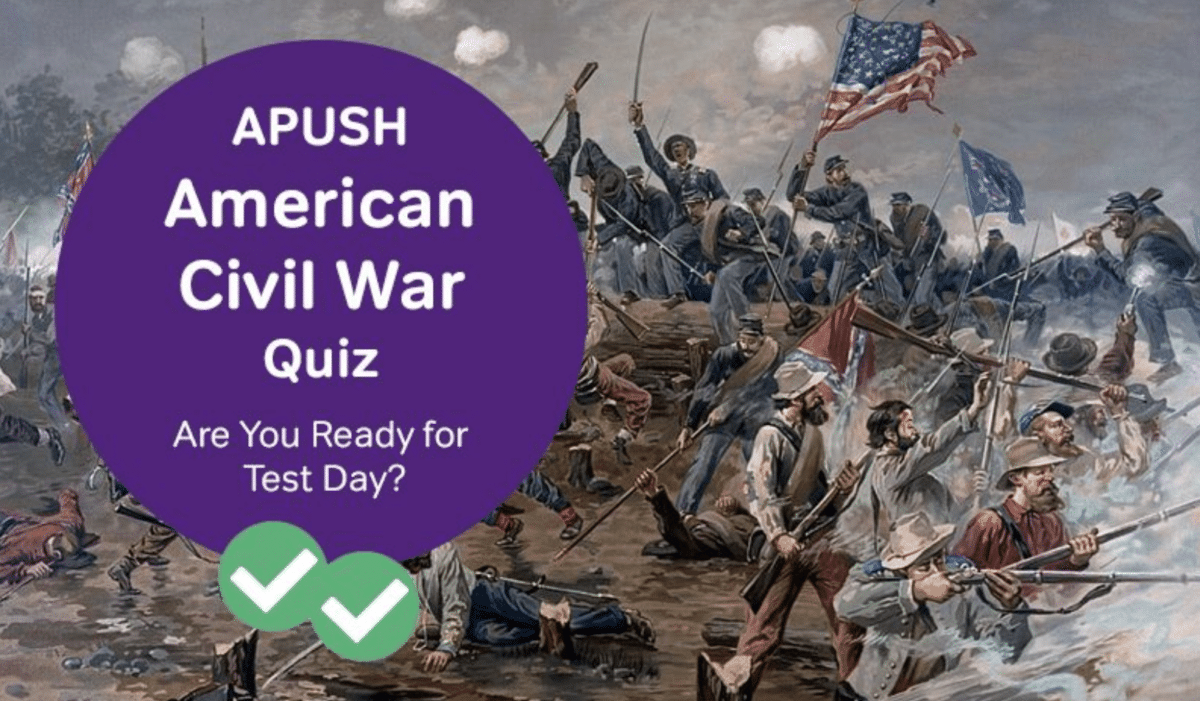
Your AP US History exam is approaching! How are you feeling about it? Undoubtedly, there are some topics you feel stronger about than others. The Civil War is a central topic on the exam, so we’ve devised an APUSH Civil War quiz so you can get a sense of how well you know this material. After you’ve taken the APUSH Civil War quiz, scroll down for additional answer explanations, as well as other APUSH resources.
APUSH Civil War Quiz Answer Key With Explanations
Q#1 – Where did Robert E. Lee surrender to Ulysses S. Grant, thereby effectively ending the Civil War?
A – Appomattox Courthouse
Explanation: On April 9, 1865, Robert E. Lee, Confederate commander of all the Southern armies, surrendered to Ulysses S. Grant, commander of the Union armies. He surrendered at Appomattox Courthouse in Virginia, after the Battle of Appomattox Court House, which took place that morning and was one of the last battle of the Civil War.
Q#2 – Which union general is known for the “March to the Sea,” in which he and his troops scorched a wide swathe of the south?
A – William Sherman
Explanation: Starting November 15, 1864, William Sherman led roughly 60,000 soldiers through Georgia on the “Georgia Campaign.” Their route started in Atlanta and ended in Savannah on December 21. During this march, they destroyed military targets, civilian properties, and transportation means.
Q#3 – Who served as the president of the Confederacy?
A – Jefferson Davis
Explanation: Jefferson Davis was President of the Confederate States of America during the the Civil War. The Confederacy consisted of 11 Southern states that seceded from the Union. The first 7 to secede were: South Carolina, Mississippi, Florida, Alabama, Georgia, Louisiana, and Texas, in defense of their right to own slaves. After the start of the Civil War, Virginia, Arkansas, Tennessee, and North Carolina seceded as well.
Q#4 – Which state is associated with the word “bleeding,” on account of its being a battlefield over whether slavery should be allowed in the new territories?
A – Kansas
Explanation: “Bleeding Kansas” is another name for The Border War, which was actually a series of very violent altercations that took place in Kansas and Missouri between 1854 and 1861. Ultimately, Kansas was admitted to the Union as a free state, but many historians consider this conflict a significant precursor to the Civil War, also largely fought over the issue of states’ rights concerning slavery. This is an excellent resource on APUSH topics related to Bleeding Kansas.
Q#5 – What was the name of the chief justice who ruled in the Dred Scott case?
A – Roger Taney
Explanation: Dred Scott v. Sandford was a Supreme Court case that took place in 1857. Dred Scott, a slave, attempted to sue for his freedom, since he was moved to free territory by his master. The United States Supreme Court, led by Justice Roger B. Taney, ruled against Scott, declaring that black individuals were not considered citizens of the United States. This ruling is often considered among the most upsetting and oppressive in American history. Here is a more thorough overview of APUSH topics related to The Dred Scott decision.
Q#6 – Which amendment formally abolished slavery?
A – 13th Amendment
Explanation: The 13th Amendment to the U.S Constitution, officially ending slavery, was passed by Congress on January 31, 1865 and ratified on December 6, 1865. It declares that “Neither slavery nor involuntary servitude, except as a punishment for crime whereof the party shall have been duly convicted, shall exist within the United States, or any place subject to their jurisdiction.” Previous to this, on January 1, 1863, President Lincoln issued the Emancipation Proclamation, in which he stated “that all persons held as slaves are, and henceforth, shall be free.”
Q#7 – What was the costliest battle in terms of the total number of lives lost?
A – Gettysburg
Explanation: During the 3-day Battle of Gettysburg, General Robert E. Lee attempted to invade the North by entering Gettysburg, Pennsylvania. From July 1-July 3, 1863, 52,000 men were wounded, killed, or missing in action. The battle was a turning point of the war, leading to Confederate retreat and halting their progress.
Q#8 – Which of the following states was, in a sense, both the last to join the Confederacy and the last to join the Union, a split reflected in the name of the two states to this very day?
A- Virginia
Explanation: Virginia joined the Confederacy reluctantly in 1861, after Abraham Lincoln became president. In 1863, because the state was heavily divided on account of slavery, West Virginia became the 35th state to be admitted to the Union. Read more here on Virginia’s involvement in the Civil War.
Additional Civil War Resources
For more information on how the Civil War is tested on the APUSH exam, check out the following:
- The American Civil War: APUSH Topics to Study for Test Day
- This highly comprehensive overview of the American Civil War
Other Themes on the APUSH Exam
In addition to questions specifically about the Civil War, you should also familiarize yourself with the following topics and themes, which will be addressed throughout the exam:
Other Ways to Prepare for the APUSH Exam
Know your APUSH basics
You’ve probably been discussing this exam all year in your AP US History course, but it can be helpful to review the actual structure of and assessments on the test on your own. This APUSH overview goes over exactly what will be on the test, including question formats and types. It also covers key concepts, events, and strategies.
This is also a great resource covering 9 thematic topics on the APUSH exam, to help you brush up on everything from the British Colonies to the Cold War. Along those lines, it’s also worth studying the specific historical periods that show up on the APUSH exam.
Take an APUSH practice exam
You know the saying: practice makes perfect! You probably take practice tests in your AP US History class as part of your curriculum, but you can always take them at home as well. Here are some tests for more practice:
Take these other APUSH quizzes
If you liked this APUSH Civil Rights quiz, check out these other APUSH quizzes!
Form APUSH study groups and share resources
Let’s face it, working together is always more fun. Try getting together with a few peers from your AP US History course weekly to refresh yourselves on key concepts, review practice test questions, divide and conquer searching for answers, etc. Here are some of our favorite APUSH resources:
- The Best APUSH Study Notes
- This APUSH Study Plan (with various timelines included)
- These APUSH Outlines
- These APUSH Study Guides
- This APUSH Crash Course
A Final Word on APUSH Testing Day
AP Exams can be stressful, and there’s a lot of information on the AP US History exam, but we believe in you! The earlier you can start studying, the better, and here are some tips for studying smarter.
Are you looking for more AP US History Exam Prep? We’ve got you covered!
Happy studying and best of luck on test day!



Leave a Reply